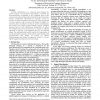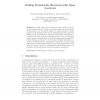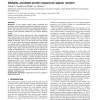1065 search results - page 106 / 213 » Predicting Peroxisomal Proteins |
ICCAD
2008
IEEE
14 years 5 months ago
2008
IEEE
Proteins crystallization is a commonly used technique for protein analysis and subsequent drug design. It predicts the three-dimensional arrangement of the constituent amino acids...
ECAL
2007
Springer
14 years 2 months ago
2007
Springer
Abstract. Proteins, under native conditions, fold to specific 3D structures according to their 1D amino acid sequence, which in turn is defined by the genetic code. The specific...
BIOINFORMATICS
2010
13 years 8 months ago
2010
Motivation: To test whether protein folding constraints and secondary structure sequence preferences significantly reduce the space of amino acid words in proteins, we compared th...
JCB
2007
13 years 8 months ago
2007
In our recent work, a new approach to establish sequence relatedness, by walking through the protein sequence space, was introduced. The sequence space is built from 20 amino acid...
BMCBI
2008
13 years 8 months ago
2008
Background: Most methods available to predict protein epitopes are sequence based. There is a need for methods using 3D information for prediction of discontinuous epitopes and de...



